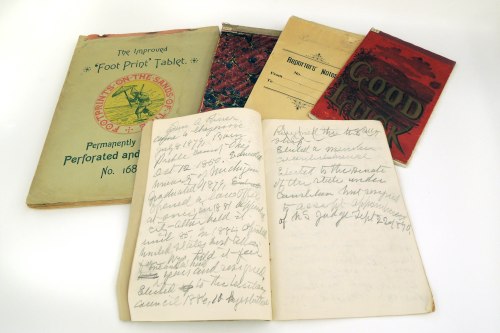Not satisfied with the commercially produced mattresses available today? Have you ever wonder how to make your own? Well thank goodness the Wyoming Agricultural Extension Service (now the University of Wyoming Cooperative Extension Service) can help! Since 1914, in addition to providing advice on livestock and crops, the Extension Service provided folks with demonstrations and workshops on everything from canning garden produce and sewing clothes to how to use color in home decoration and how to refinish furniture. In this series of photos from the 1940s, Wyoming Home Economics Specialist Pauline Bunting helps an unidentified community group stitch and stuff mattresses.
Between 1987 and 1989, the Wyoming Extension Homemaker’s Council interviewed many of the long time homemakers club members about their experiences with homemakers extension clubs over the years. Many of these women started in the clubs in the 1930s and 1940s as new brides. Several mentioned community mattress making projects and demonstrations like this one during their club days, and especially during the early 1940s and World War II.
In the fall of the year we used to make mattresses. We went to the community hall, everyone in the neighborhood that needed mattresses. The government would furnish the cotton and the material for the mattresses, but we had instructions that showed us how to make ’em. We could make about four mattresses at a time… I can’t remember how long it took us to make a mattress, three days I think. By the time we got finished, everyone [had] a mattress… [Folks came by] Model T’s or team and wagon or whatever. Some of them came on horseback. We’d take our lunch and stay all day. We were pretty tired at the end of the day. — Mabel Doris Hageman of Douglas, Wyoming (H98-44 Box 4)
The first step was to make patterns and cut out the ticking for the mattress covers. Ticking is the sturdy cotton fabric used for mattress and pillow covers. It is usually off-white with brightly colored pin-stripping.
Here an extension agent helps a man sew the ticking together for the mattress cover. They are wearing bandannas over their noses so they do not breath in the fine cotton dust.
Weighing cotton for stuffing the mattresses. Notice the bandannas again. Cotton came in large bats and the cotton was weighed out to ensure each mattress received its fair share. According to a 1940s USDA circular, 50 pounds of cotton went into each mattress.
Rolling out the cotton onto the ticking. Rolling rather than stuffing produced a more even mattress.
Then it is time to add the top ticking and stitch it to the sides. The stick that is waiving in the foreground is a broomstick used to beat out the lumps in the stuffing.
We’d go down there and we’d take our broom, and I suppose you’re wondering how a broom helped? We had to beat ’em when we got those layers in. We had to beat those layers of cotton so long to mat ’em together. — Mabel Doris Hageman
After the ticking is sewn closed, a welt was sewn around the edges to give it shape and keep it square. Look how handy these men are with those long needles!
Almost done!
The mattress was then couched to keep the stuffing from shifting. Couching is a process where you attach buttons to each side of the mattress and pull them tightly together. The buttons keep the thread from pulling or wearing holes in the fabric.
The finished mattress is ready for a bed and a good night’s sleep after all that work.
For more information, take a look at this wonderful ca 1940 circular from the USDA encouraging farm families, especially in the south, to turn surplus cotton into mattresses. Thanks to our friends at the National Agricultural Library Special Collections for digitizing this gem!



















